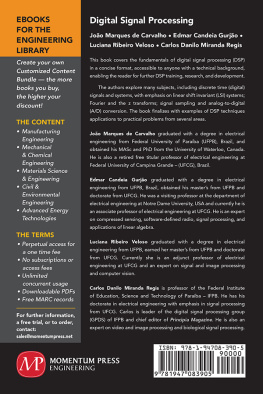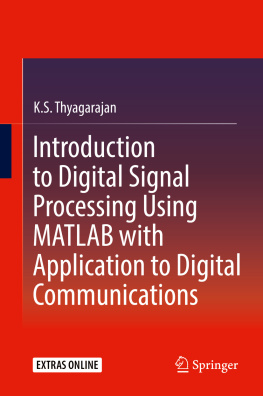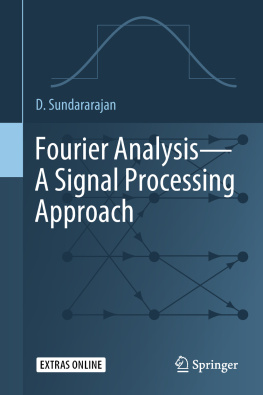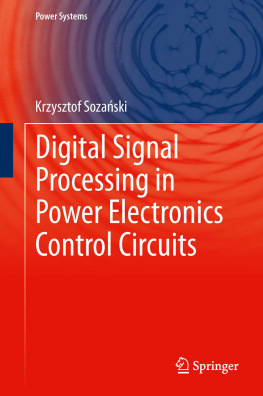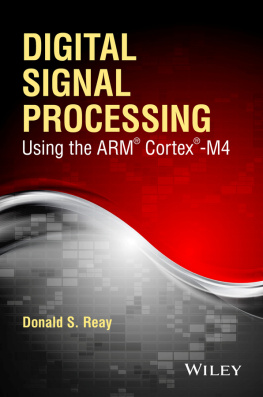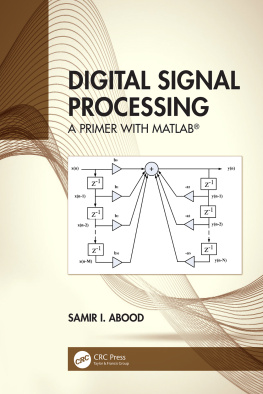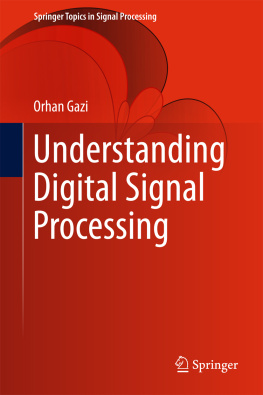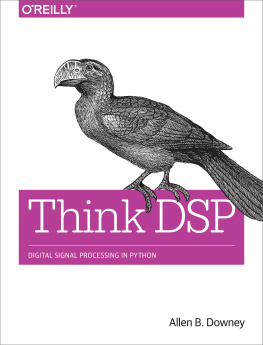
DIGITAL SIGNAL
PROCESSING
DIGITAL SIGNAL
PROCESSING
JOO MARQUES DE CARVALHO,
EDMAR CANDEIA GURJO,
LUCIANA RIBEIRO VELOSO, AND
CARLOS DANILO MIRANDA REGIS

Digital Signal Processing
Copyright Momentum Press, LLC, 2019.
All rights reserved. No part of this publication may be reproduced, stored in a retrieval system, or transmitted in any form or by any meanselectronic, mechanical, photocopy, recording, or any otherexcept for brief quotations, not to exceed 400 words, without the prior permission of the publisher.
First published by Momentum Press, LLC
222 East 46th Street, New York, NY 10017
www.momentumpress.net
ISBN-13: 978-1-94708-390-5 (print)
ISBN-13: 978-1-94708-391-2 (e-book)
Momentum Press Communications and Signal Processing Collection
Collection ISSN: 2377-4223 (print)
Collection ISSN: 2377-4231 (electronic)
Cover and interior design by Exeter Premedia Services Private Ltd., Chennai, India
10 9 8 7 6 5 4 3 2 1
Printed in the United States of America
ABSTRACT
In this book, we present the fundamentals of digital signal processing (DSP) in a format which is both concise and accessible to anyone with an engineering or sciences background. Without sacrificing the fundamental theory and concepts, we provide the reader with knowledge that capacitates him or her for further reading or for using available DSP tools.
The initial chapters provide the background for proper understanding of DSP techniques. We start by presenting discrete-time (digital) signals and systems, with emphasis on the class of linear shift invariant (LSI) systems, as those are used to model most systems of practical interest. In the sequence, we introduce the Fourier and the z transforms, which are essential signals and systems analysis tools, followed by signal sampling and analog-to-digital (A/D) conversion.
The discrete Fourier transform (DFT) and its computationally efficient form, the fast Fourier transform (FFT), are examined next. FFT algorithms have been widely used in different DSP applications, either in software or in hardware implementation, for real-time signal processing in the frequency domain at very high sampling rates.
The largest chapter of this book is dedicated to digital filters, which are an essential component of most DSP systems. We analyze and compare the two main filter classes: infinite impulse response (IIR) and finite impulse response (FIR) and the structures used for their implementation. We also describe how to specify a digital filter and the main design techniques for both IIR and FIR filters. Examples are presented throughout the chapter.
In the final chapter, we present examples of DSP techniques applications to practical problems from several areas, including time and frequency analysis of signals, biomedical signal processing, audio processing, and digital communications.
KEYWORDS
A/D conversion; digital signal processing; digital filters; fast fourier transform; fourier transform; signals sampling
CONTENTS
Motivation for this book comes from the assessment that technological knowledge transmission should not be restricted to the traditional sequence of courses present in most undergraduate programs. Those courses have and will maintain in the foreseeable future a vital role in the formation of qualified professionals. Nevertheless, there is an ever-growing need for texts written in a concise (although not less accurate) format to teach in a few hours the basic theory and essential techniques of a subject, as well as to provide understanding of some related applications. This book aims to fill this gap, being directed to people who need to acquire the fundamentals of digital signal processing (DSP) in a short time, during a three hours flight, for example.
DSP works with digital representations of signals, modifying those in order to improve their analysis, transmission, and reception. Starting in the 1960s, the use of DSP has been growing continuously, because of the development of powerful and efficient methods, particularly filter design techniques and fast Fourier transform (FFT) algorithms, opening several application areas. The advancement of integrated circuits technology further contributes to the popularization of DSP, allowing for high-speed implementations of complex processes.
In this book, we present the fundamentals of DSP in a concise format accessible to anyone with an adequate mathematical background. We do not assume a previous course on signals and systems, as is usually the case with undergraduate textbooks. Knowledge of differential and integral calculus and of finite and infinite sequences and series, as well as complex numbers, is the basis needed to read and understand the present text.
Our book should be of interest to anyone with an engineering or sciences background who must attend on a short notice a technical meeting or who needs to use a DSP software tool, but does not have enough time to learn all theory behind the involved methods. As an example, DSP textbooks typically describe in details optimization techniques for equiripple FIR filters parameters selection or for minimizing IIR filters frequency response mean-square error. Those details were originally justified because the filter designer had often to implement those optimization algorithms. However, many software libraries and toolboxes are currently available with filter design and implementation modules, requiring only a set of specifications from the user. Thus, the designer can focus on determining the best set of filter specifications for the problem at hand, instead of spending time to learn all involved methods. In addition, this book can also be used as a textbook for an advanced undergraduate or graduate course in DSP with emphasis on problem solving. This type of course usually starts with the analysis of an application problem, from which theory is introduced only as required to progress toward a solution.
We start the book in looking at the fundamentals of discrete-time signals and systems. Signals properties are presented, and the unit step, unit impulse, and complex exponential signals are defined and analyzed. After describing the basic properties of discrete-time systems, we focus on linear shift invariant systems, as those are used to model most systems of practical interest. The discrete convolution operation is defined and its computation analyzed.
.
Signal sampling and analog to digital (A/D) conversion is the subject of analyzes sampling and reconstruction, or sampling rate reduction and increase, of discrete-time signals performed by the decimation and interpolation operations, respectively.
In periodic and continuous in frequency, DFT provides a finite-length discrete frequency domain representation of a signal. We present the concept of circular convolution, show how DFT is applied to an infinite-length signal, and analyze effects of leakage and windowing on DFT.
Despite its potential for DSP applications, DFT was initially of limited practical use due to its high computational complexity. The amount of complex multiplications required for a direct DFT calculation of a size N signal is of order N2. Only with the advent of the family of algorithms known as fast Fourier transform (FFT), this complexity was reduced to order N log2N, making it feasible for implementation in DSP systems.
The decimation in time formulation of the FFT is derived in , as well as the structure known as butterfly, which implements the basic computation for that FFT form. We show how butterflies can be combined to calculate larger-size FFTs.
Next page
